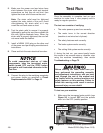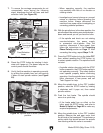
-24-
Model G0740 (Mfg. Since 11/12)
— If using the included leveling pads (see
Figure 19), place them under the six level-
ing jack bolt locations, then adjust the bolts
to level the lathe.
Assembly
With the exception of the handwheel handles, the
lathe is shipped fully assembled.
To install the handwheel handles, thread the large
handle into the carriage handwheel and the small
handle into the cross slide handwheel, as shown
in Figure 21.
Figure 21. Handwheel handles installed.
Handwheel
Handles
Lubricating Lathe
The headstock, quick-change gearbox, and apron
oil reservoirs must have the proper amount of oil
in them before the lathe can be operated initially.
Damage caused to the bearings and gears from
running the lathe without oil in the reservoirs
will not be covered under warranty. Refer to the
Lubrication section, beginning on Page 65, for
checking and adding oil.
GEARBOXES MUST
BE FILLED WITH OIL!
LATHE MAY NOT
HAVE OIL INCLUDED!
Refer to the Lubrication
Section in this Manual
for Recommended
Oil Type.
Unless otherwise specified by your local
codes, this machine MUST be secured to
the floor if it is permanently connected
(hardwired) to the power supply.
— If using mounting hardware that does not
allow for adjustment, level the lathe by
placing metal shims between the lathe
base and the floor before bolting it down.
Figure 19. Leveling pads and screws.
Jack Bolts
Pads
Bolting to Concrete Floors
Figure 20. Typical fasteners for mounting to
concrete floors.
Lag screws and anchors, or anchor studs (see
Figure 20), are two popular methods for bolt-
ing machinery to a concrete floor. We suggest
you research the many options and methods for
mounting your machine and choose the best one
for your specific application.
Anchor
Stud
Lag Screw
and Anchor


















